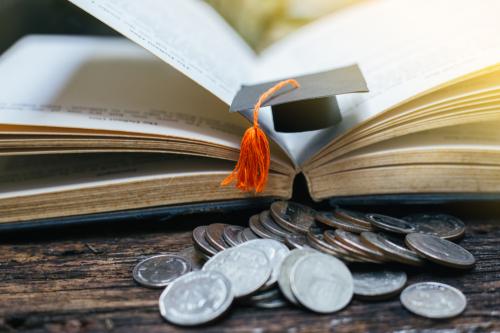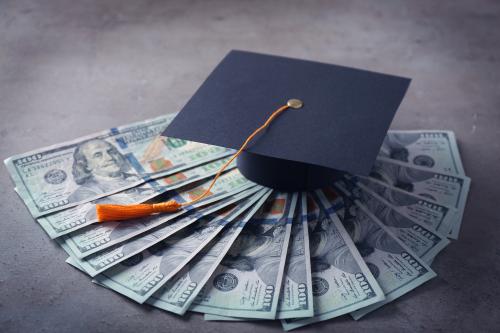When it comes to the disaster that is our student loan system, some debt forgiveness will undoubtedly be part of the solution. Millions are in default on their loans. Many can’t afford to pay. Other borrowers struggle with debts for degrees they did not complete or failed to lead to a good job. In many cases, trying to collect on bad loans isn’t worth the cost to taxpayers or hardship imposed on borrowers. Student loans should be a vehicle for economic opportunity, not a financial life sentence.
So the policy issue is not whether to forgive some debt, but how and for whom. Debt forgiveness could be an opportunity to redress failures of the current system, make college financing more fair and equitable, and provide hope not just for existing borrowers, but also to future students who will borrow to pay for college and graduate school. Tomorrow’s students need confidence the government has a plan to help them, too.
But widespread, immediate, and one-off debt forgiveness—$10,000 for everyone, regardless of circumstances, ignoring that students are going to borrow another $100 billion next year—doesn’t accomplish any of those goals. But a targeted, gradual approach to debt forgiveness could.
One-off, across-the-board forgiveness is capricious and unfair
Widespread debt forgiveness isn’t equitable because student debt is mostly owed by higher-income, better-educated borrowers, from affluent, mostly white backgrounds. Eligibility for federal loans is not based on income—virtually all American students are eligible—and loans can be a convenient and inexpensive way to finance tuition or living expenses even for families who can “afford to pay.” As a result, who owes student debt and how much they owe mostly reflects who goes to college, whether they complete college and go to graduate school, and whether they attend an expensive school.
High-income families are six times more likely to send their children to college as low-income families. If you meet someone with a recent graduate degree, more than half grew up in a high-income family. Black and Hispanic Americans remain woefully underrepresented at every level of postsecondary educational attainment and are less likely to complete degrees. Many student loan borrowers do well after college—the wages of young college and professional-degree graduates are at all-time highs. Forgiving debt of affluent, high-income, well-educated, mostly white Americans makes society more unequal, not less.
One-off, across-the-board forgiveness is capricious and unfair in other ways. Why does an Ivy-league professional-degree graduate deserve the same relief as a student who pursued a low-cost community college degree? Why should the class of 2022 get a windfall, but not students who enroll next year? Why should a borrower who spent years paying down a balance get the same or less than someone who graduated yesterday?
Students borrow close to $100 billion each year but are eligible to borrow roughly three times as much, so the precedent matters for how much future students borrow and repay, not to mention how much colleges charge. As flawed as the current system is, it can get worse.
In his campaign, President Biden described an enduring reform that included increased grant aid for low- and middle-income students, funding to reduce tuition at public colleges, and a more forgiving income-driven repayment (IDR) system. That vision expands on our broadly-supported system of Pell grants and support for public colleges, but it also reflects some hard truths: There’s no case for taxpayers subsidizing sky-high private school tuition, children from high-income families, or graduate and professional degrees.
Done well, debt forgiveness could advance that vision.
So the policy issue is not whether to forgive some debt, but how and for whom.
Biden proposed doubling the maximum Pell grant from its current $6,500 level. He could forgive a similar amount of debt for existing low-income and middle-income borrowers and promise to do so each year for future low-income borrowers in case Congress does not act on his proposal. Targeting aid based on data the Department of Education already maintains from financial aid forms (like family income and Pell eligibility) and whether the student was an undergraduate is more expedient than trying to cap forgiveness based on current income. Using these measures to target relief would be progressive and cost-effective. Pell grant recipients, after all, represent 90 percent of borrowers who default on a student loan. And proposing to provide the same help paying for college for both past and future students would be coherent and fair.
No free college plan contemplates free graduate school or subsidized tuition at expensive colleges or for high-income families. Those students—past and future—should expect to begin repaying their loans. Biden’s administration is currently implementing new IDR plans and a fresh start for defaulted borrowers, which will ease the burden on borrowers and accelerate loan forgiveness Congress enacted. Those policies will help future and current borrowers alike. Loan repayment need not start immediately; Biden’s new regulatory policies should be in place first.
The best way to target relief to struggling borrowers is through IDR plans, which calibrate loan repayment to borrowers’ incomes and forgive remaining debts after 20 or 25 years. Gaps in student loan debt widen after graduation by race, economic status, and parental education, as well off borrowers pay down their loans while others can’t. That makes IDR’s eventual forgiveness highly targeted to disadvantaged groups and more progressive than across-the-board relief.
IDR plans were enacted too recently and implemented so poorly, however, that almost no borrowers have yet to receive forgiveness. Millions more borrowers accumulated interest and fees or defaulted on loans in the absence of IDR’s protections. Biden could use debt relief to fix that, too, and in doing so instill new confidence that these programs will work for future students. For example, Biden could provide relief based on years in repayment (e.g., forgiving some amount for each year in repayment beyond 10 years, so borrowers who graduated long ago got the most relief) or forgiving balances in excess of the original principal balance (and disposing of accumulated interest and fees) or forgiving remaining debts of borrowers whose cumulative payments exceeded the amounts they should have paid under a standard plan. Those options would be highly targeted to borrowers who have struggled with their loans over many years, would dispose of loans that were unlikely to be paid otherwise, and could mirror the aid that future borrowers could expect from revamped IDR plans. Some borrowers would get less than $10,000 and some would get more, commensurate with their situation. Future borrowers would have more confidence the government intends to make the IDR system work for them, too.
A regular criticism of targeted policies is that they are too complicated or that the government can’t be trusted to implement them. Those criticisms are too true when it comes to the history of student lending. By implementing a targeted policy quickly and effectively with information the Department of Education already collects for this purpose, Biden can restore trust that the government can get nuanced policies right. Americans need a student lending system to work in the future, to command broad, bipartisan support, and be economically sustainable. A targeted, coherent, and purposeful loan relief policy could be step toward that goal.
The Brookings Institution is financed through the support of a diverse array of foundations, corporations, governments, individuals, as well as an endowment. A list of donors can be found in our annual reports published online here. The findings, interpretations, and conclusions in this report are solely those of its author(s) and are not influenced by any donation.






Commentary
Op-edBiden can and should target student-loan debt forgiveness
May 31, 2022